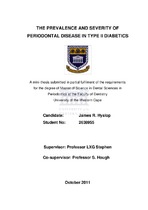The prevalence and severity of periodontal disease in Type II diabetics
Abstract
Introduction: The relationship between Periodontal Disease and Type II diabetes has been reported in recent literature. More recent studies suggest that further research is required into the relationship of glycaemic control on Periodontitis. The main aetiological factor in Periodontal Disease is plaque; however other secondary factors such as Diabetes Mellitus, neutrophil abnormalities, smoking, socio-economic status, age, stress, Human Immunodeficiency Virus (HIV) infections, pregnancy, sex hormones, osteoporosis and several other conditions play an important causative role (Genco, 1993). Aim: The purpose of this study is to test the hypothesis that the prevalence and severity of periodontal disease is greater for patients with poorly controlled Type II Diabetes Mellitus (DM-2) compared to those with better controlled Type II Diabetes Mellitus. Methods: 'Coloured female patients', who were diagnosed with Type II diabetes were included in the study. Demographic information, medical history and HbA1c levels were recorded by the attending physician in the diabetes unit. Periodontal examination was carried out by a single examiner. This included a plaque index (PI), a gingival index (GI), bleeding on probing (BoP), probing depths (PD) and clinical attachment loss (CAL). These measurements were recorded on Ramfjord teeth. The presence of any one sextant showing PD of ≥ 4 mm or clinical loss of attachment of ≥ 3 mm was diagnosed as periodontitis. Results: Poor glycaemic control was associated with more severe periodontitis. Conclusion: The results of the study showed that it could be justified that the regression approach (correlation) be applied to the complete sample of 63 individuals. Most of these correlation coefficients were positive and significantly different from zero, indicating that 'HbA1c' had a detrimental influence on the periodontal measurements; within the limitations of the study. This link could be indirect in that some other properties of diabetes, and not necessarily 'HbA1c', affected the dental health of diabetics adversely.

